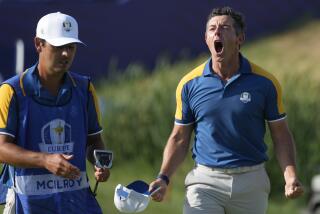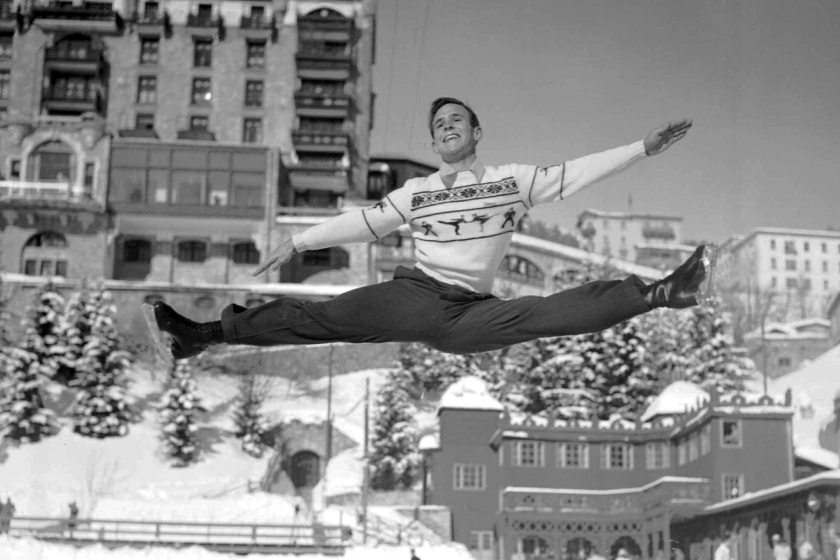After a Period of Dominance, Americans Finding Faults : Equestrian: U.S. competitors hoped to do well in Volvo World Cup, but their struggles continue.
- Share via
DEL MAR — The question came about an hour after the competition ended from a member of the European press corps. There had been enough time to evaluate the standings of this 1992 Volvo World Cup, and a clear pattern had developed.
“Why doesn’t the United States do better in these competitions against the Europeans?”
On the receiving end of the question was Leslie Lenehan, whose third-place finish in Round 2 moved her into 12th place overall for the Volvo World Cup title.
Lenehan wasted no time with her response.
“Do you have an hour?”
As a matter of fact, yes. So here we go, 60 Minutes, minus Andy Rooney.
What’s wrong with the Americans? The clock is running.
Tick, tick, tick, tick, tick. ...
Judging by the current standings for the World Cup individual title, one would never guess that Americans dominated this sport in the early 1980s. Now, they’re simply vying for a position in the top 10.
American trainer George Morris, president of the Show Jumping Hall of Fame and a member of the board of directors for the United States Equestrian Team (USET): “In baseball, we’re the center of the world. In riding, Europe is the center of the world.
“From the 1950s to the ‘80s, we were right there, and for four or five years, we just dominated. We were the epicenter. But for a hundred years before and a hundred years after, (Europe’s) the center of the sport.”
That theory played itself out in the standings after two rounds. Austrian Thomas Fruhmann leads, followed by three Swiss riders, one from Great Britain, France and Belgium and two from Germany.
Maggie Goldstein is the highest-placing American. One of 15 competing, she is tied for 10th, 21 points behind Fruhmann.
The way the scoring is set for today’s final round, the only way an American will win at the Del Mar Fairgrounds is if a tsunami wipes out half the horse compound, and the forecast is for clear and sunny.
There are three Americans in the top 15. There are seven in the bottom 17 in the 46-rider field.
But there is more to the pattern that has enveloped this competition.
* The first World Cup was held in 1979 and won by an Austrian. Americans won seven of the next eight titles, the last coming in 1987 for Katharine Burdsall on The Natural.
* The U.S. won the team gold medal at the 1984 Olympic Games in Los Angeles, and American Joe Fargis won the individual gold.
* Americans also won the gold at the 1986 World Championships.
* Americans won the team and individual silver (Greg Best) at the 1988 Olympics.
* At the 1990 World Championships, Americans won nothing.
* Since 1987, George Lindemann’s third-place finish in 1989 is the country’s only top-three finish in the World Cup.
Tick, tick, tick, tick. ...
This year’s World Cup was made to order for the Americans. It is being held in the United States for only the third time, and the Yanks had high hopes. The leading West Coast rider, Rancho Santa Fe’s Bernie Traurig, trains just up the road from the fairgrounds and said beforehand that his chances of winning would never be better. He’s tied for 13th.
Maybe it’s a curse. Or sloppiness. Or attitude. Or maybe all three.
“The standards today are a little watered down,” said American Anne Kursinski, 33, who grew up in Pasadena and moved to Westport, Conn., in 1981. She has an Olympic silver medal, two Pan-American golds, an Equestrian of the Year title and a victory last year in Aachen, Germany, arguably show-jumping’s most prestigious event. After finishing sixth in the first round, she’s currently tied for 17th with two others.
Said Kursinski:”To win the gold medals and be the best in the world has to be the main focus--which is what we did years ago--not to be a big fish in a small pond.”
Americans used to be sharks. Today, they’re somewhere down on the food chain.
Tick, tick, tick. ...
Among the factors that led to the equine decline of America:
* Economy. The American dollar has dwindled in worth abroad. Those sponsors who can afford to purchase the best horses often do so for their own children, who are advanced amateurs.
* Course layout. The courses in American Grand Prix don’t have the big jumps that European layouts do. So when there is a first-class world competition--which is how Morris described this week’s event--the horses aren’t ready.
* Horses. For years, Americans were lining the pockets of European sellers and then beating them with the European horses. The Europeans wised up. “Now, they’re selling us their second-best,” Morris said. “We’re using (American) race horses that aren’t good enough for the race track. We’ve got to utilize our own resources more.”
* Smugness. “I think we got very comfortable, we became the best in the business, and we stopped in our tracks,” Kursinski said.
* Neglect of the top riders. The best riders are, in the words of Morris, “left to their own devices.” They don’t get the backing to do all the things that are necessary to excel. “Not enough time, thought or effort has been put into the top grade of riders,” Morris said. “I said this back in ‘86-87 when we were winning.”
* Direction. Former USET Coach Bert de Nemethy, who ruled with an iron fist from 1953-80, set the foundation that led to the U.S. supremecy, but a couple of challenges to the selection of Olympic and World Championship teams in the late 1980s--both were turned back--have led to a more splintered training process. “Today, everyone is going in their own direction,” Kursinski said.
* Competition: “(Under de Nemethy) we used to go on six-week tours of Europe and find out where we were weak,” Morris said. “You don’t really find that out when you’re competing against one another. Here, when you get to the top, everyone does well, but we’re all playing with each other, we see the same riders, the same horses, the same fences.”
Tick, tick. ...
What’s wrong with the Americans? They were committed to being the best, then let the world catch them. Now, it may be too late to recapture the magic that this country enjoyed from 1980-86.
“We’re never going to dominate again like we did those five or six years,” Morris said. “We caught (the Europeans) with their pants down because they stopped learning. That won’t happen again.”
Tick.
Notes
Austria’s Thomas Fruhmann leads the Volvo World Cup point standings as it enters its final day. Competition today begins at noon. Fruhmann will begin the day with no faults against him, while the other competitors will begin the competition with a certain number of faults based on their position in the standings. For every rail that is knocked down in today’s two full rounds, four faults will be incurred. The standings: Fruhmann (no faults), followed by Switzerland’s Markus Fuchs (3.00), Thomas Fuchs (3.50) and Lesley McNaught-Maendli (6.50), Great Britain’s Tina Cassan (7.00), France’s Phillipe Rozier (7.50), and Belgium’s Evelyn Beerbaum (8.00). Only those who have fewer than two rails to make up are considered to have a reasonable chance of winning. . . . Canadian Ian Millar won $15,000 by riding Big Ben to the Class 11 Grand Prix of Del Mar title on Saturday. . . . Allain Vaillancourt, astride Lybelle, won $3,000 for winning the Class 10 Fault and Out. American Diann Langer took second. . . . McClain Ward rode Palermo to the victory and $3,000 in the Class 16 Junior/Amateur Owner Grand Prix.
More to Read
Go beyond the scoreboard
Get the latest on L.A.'s teams in the daily Sports Report newsletter.
You may occasionally receive promotional content from the Los Angeles Times.






